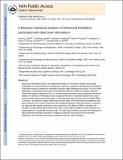A Bayesian statistical analysis of behavioral facilitation associated with deep brain stimulation
Author(s)
Smith, Anne C.; Shah, Sudhin A.; Hudson, Andrew E.; Purpura, Keith P.; Victor, Jonathan D.; Brown, Emery N.; Schiff, Nicholas D.; ... Show more Show less
DownloadBrown-A Bayesian statistical analysis.pdf (1.170Mb)
OPEN_ACCESS_POLICY
Open Access Policy
Creative Commons Attribution-Noncommercial-Share Alike
Terms of use
Metadata
Show full item recordAbstract
Deep brain stimulation (DBS) is an established therapy for Parkinson's Disease and is being investigated as a treatment for chronic depression, obsessive compulsive disorder and for facilitating functional recovery of patients in minimally conscious states following brain injury. For all of these applications, quantitative assessments of the behavioral effects of DBS are crucial to determine whether the therapy is effective and, if so, how stimulation parameters can be optimized. Behavioral analyses for DBS are challenging because subject performance is typically assessed from only a small set of discrete measurements made on a discrete rating scale, the time course of DBS effects is unknown, and between-subject differences are often large. We demonstrate how Bayesian state-space methods can be used to characterize the relationship between DBS and behavior comparing our approach with logistic regression in two experiments: the effects of DBS on attention of a macaque monkey performing a reaction-time task, and the effects of DBS on motor behavior of a human patient in a minimally conscious state. The state-space analysis can assess the magnitude of DBS behavioral facilitation (positive or negative) at specific time points and has important implications for developing principled strategies to optimize DBS paradigms.
Date issued
2009-10Department
Harvard University--MIT Division of Health Sciences and Technology; Massachusetts Institute of Technology. Department of Brain and Cognitive SciencesJournal
Journal of Neuroscience Methods
Publisher
Elsevier
Citation
Smith, Anne C. et al. “A Bayesian Statistical Analysis of Behavioral Facilitation Associated with Deep Brain Stimulation.” Journal of Neuroscience Methods 183.2 (2009): 267–276.
Version: Author's final manuscript
ISSN
0165-0270